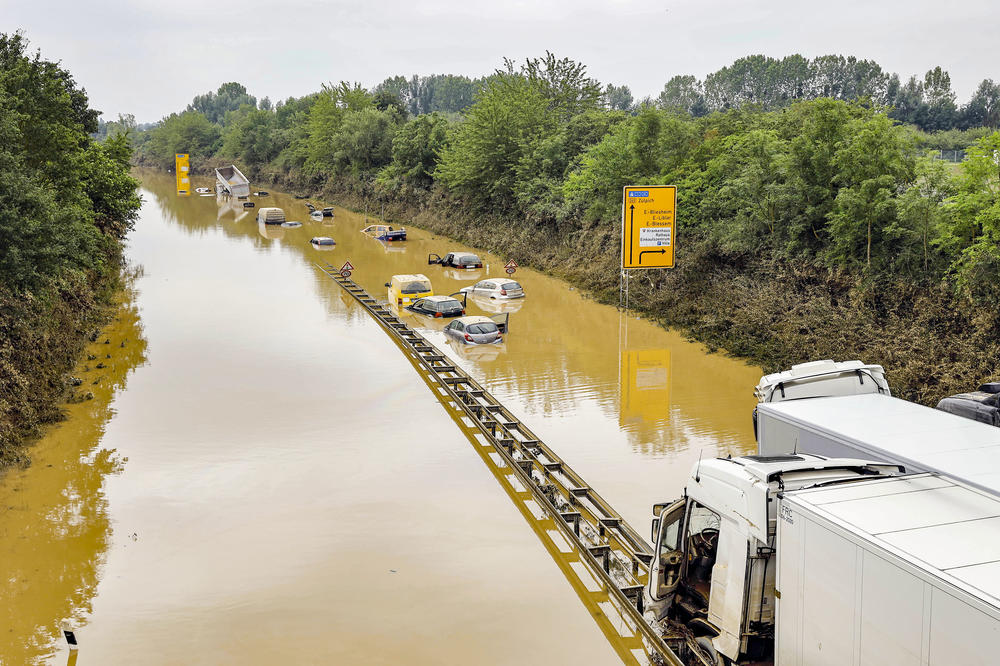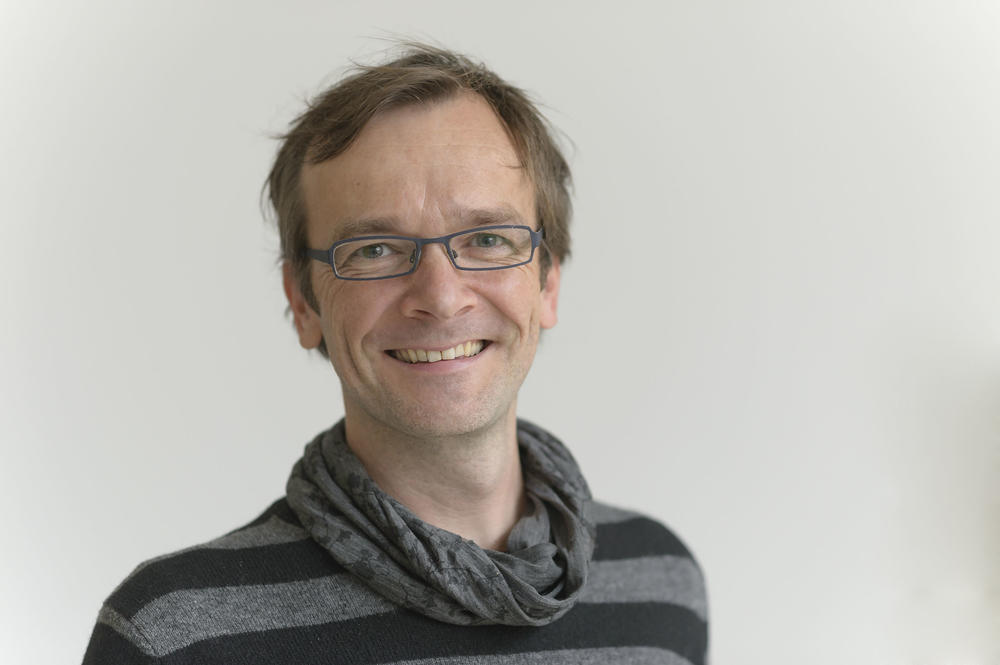When the Weather Turns into a Disaster
Floods on the Ahr and Wupper rivers triggered new fears: How often do we have to expect extreme weather in the future? Can the consequences of climate change be limited? Research at the Institute of Meteorology provides some answers.
Oct 25, 2021
In July 2021 cars and trucks on the highway near Erftstadt-Liblar in North Rhine-Westphalia were surprised by masses of water.
Image Credit: picture alliance / Geisler-Fotopress
At the end of a short, steep incline – very rare in Berlin – a modern, functional building lies between older villas. Only the doorbell on the building on Carl-Heinrich-Becker-Weg in Steglitz indicates what it is: the Institute of Meteorology at Freie Universität Berlin with a focus on climate science.
To see Stephan Pfahl, a professor and head of the working group for weather and climate processes, you have to walk through long corridors with low ceilings. The office itself looks surprisingly spacious, with colorful children’s drawings hanging on the walls. “We can still influence how severe the climate crisis will be,” says Professor Pfahl, referring to the children’s drawings. “Depending on whether the Earth heats up by an average of 1.5 degrees, by 2 degrees, or by more than 3 degrees, the effects will differ considerably,” he explains.
Professor Stephan Pfahl says, “We can still influence how severe the climate crisis will be.”
Image Credit: Petra Grasse
The names of the research projects supervised by climate scientist Stephan Pfahl reflect the impact of global warming, for example, “Dynamics of heat waves” or “Extreme precipitation events.” With the latter project, Stephan Pfahl and his team want to find out how great the chances are that such extreme precipitation as experienced on the Ahr and Wupper rivers in southwestern Germany this past summer will increase.
The project is part of a large-scale research project called “climXtreme” being funded by the German Federal Ministry of Research. In climXtreme, Freie Universität is collaborating with various other universities and research institutions including the Deutscher Wetterdienst (German Weather Service) and the Potsdam Institute for Climate Impact Research.
Predicting Extreme Precipitation More Precisely
By definition, extreme events are rare. Thus, there is a lack of meteorological data for conducting a systematic analysis of extreme weather. To work around this situation, researchers use computer models to generate larger samples and describe future climate trends. However, these sometimes resemble pictures with poor resolution: If you zoom in too far, you can no longer recognize anything.
Modelers are less well able to assess the impact of climate change for individual cities than for larger areas such as the Elbe region, which stretches from Prague to Hamburg, with Berlin right in the middle. Stephan Pfahl and his team can see climate change from a bird’s eye view. In order to reduce the level of uncertainty in the forecasts, Pfahl is planning a follow-up project on extreme participation. This is intended to make the forecasts more precise and to facilitate adjustments to extreme weather. Municipalities on rivers, for example, would then know more precisely how far they have to raise the dikes in order to protect themselves from extreme weather events.
Professor Uwe Ulbrich says, “My aim is to create an understanding of how we humans influence climate and how we can reduce the risk of extreme events by adapting our behavior.”
Image Credit: Personal collection
New Einstein Research Unit: “Climate and Water under Change”
Uwe Ulbrich also wants to predict what will happen. Also a professor of meteorology, Ulbrich works one floor above Stephan Pfahl. He investigates the specific impact of extreme weather on nature, people, and infrastructure. Ulbrich heads a sub-area of “climXtreme” and is one of the leading scientists behind the new Einstein Research Unit “Climate and Water under Change” (CliWaC).
CliWaC is a project of the Berlin University Alliance, a consortium consisiting of the major Berlin universities (Freie Universität Berlin, Humboldt- Universität zu Berlin, Technische Universität Berlin) and Charité – Universitätsmedizin Berlin. The spokesperson for CliWaC is Britta Tietjen, a professor of ecology at Freie Universität Berlin.
The participating scientists want to investigate what risks climate change poses for water availability and quality as well as for flooding in Berlin and Brandenburg and how the population and institutions can deal with the changing situation.
The common goal of the multidisciplinary team, which includes experts from the Berlin universities in fields ranging from ecology and hydrogeology to economics and law, is to develop solutions for the sustainable management of water resources. To ensure that the solutions are implemented, the scientists want to work closely with political decision makers, administrators, business people, and social organizations.
Professor Ulbrich explains, “My aim is to create an understanding of how we humans influence climate and how we can reduce the risk of extreme events by adapting our behavior.”
Henning Rust says it is necessary to translate the question “How will the weather be?” into “What will the weather do?”
Image Credit: Bernd Wannenmacher
“What does a 30-percent probability of precipitation mean?” asks Henning Rust rhetorically. Rust is a professor of statistical meteorology at the Hans-Ertel-Zentrum für Wetterforschung at Freie Universität. “Does it mean that it will rain on 30 percent of a day, on 30 percent of an area, or that three out of ten meteorologists are of the opinion that precipitation is to be expected? Or does it mean that it will rain in 30 out of 100 cases for which we predict the 30 percent?”
The question comes from a study by the Max Planck Institute for Human Development on the public understanding of weather forecasts. The subtitle is “A risk analysis.” That is not an exaggeration because many respondents did not know the correct answer. This study became an incentive for the scientist of statistical meteorology Henning Rust to make weather forecasts more understandable. He is currently researching how to do so in collaboration with Uwe Ulbrich in the office next door. Their project is called “Weather Extremes and Communication” (WEXICOM).
Science Can Help Answer the Question: Evacuate or Not?
Henning Rust summarizes his findings as follows: It is necessary to translate the question “How will the weather be?” into “What will the weather do?” But that is still not enough. Because the atmosphere is a complex system that can not always be predicted equally well, meteorologists speak in terms of probabilities. But in case of doubt, authorities have to decide: evacuate or not?
“In many cases, we can make such decisions easier by adding an indication of how likely they are to occur,” explains Henning Rust. However, even with the greatest transparency, there will be decisions that turn out to be false positives. “If people experience that too often, at some point they will no longer believe the warnings.”
Weather statistician Rust therefore urges that it is important to make it clear to decision makers and to the public that even when warnings are issued about events with a high degree of probability, they may not occur, but this does not make the forecasts unreliable.
Rust believes that in the end this realization will prevail. As a resourceful educator, he has developed a project to help: Henning Rust and his team have schoolchildren assemble small weather stations in class and set them up at home. “This way, children and young people can see the weather measurements in numbers on their smartphones and compare them with their own perceptions. They learn what the numbers mean and learn to better understand probability predictions and warnings,” says Henning Rust.
The weather explainer, the networker, and the climate modeler: Henning Rust, Uwe Ulbrich, and Stephan Pfahl all investigate climate change from different perspectives, and they all agree: global warming is ongoing and will further progress in the next years. But we can contain it and limit the consequences.
This text originally appeared in German on October 2, 2021, in the Tagesspiegel newspaper supplement published by Freie Universität Berlin.
Further Information
- Professor Stephan Pfahl, Freie Universität Berlin, Institute of Meteorology, Email: stephan.pfahl@met.fu-berlin.de
- Professor Uwe Ulbrich, Freie Universität Berlin, Institute of Meteorology, Email: ulbrich@met.fu-berlin.de
- Professor Henning Rust, Freie Universität Berlin, Institute of Meteorology, Email: henning.rust@fu-berlin.de




